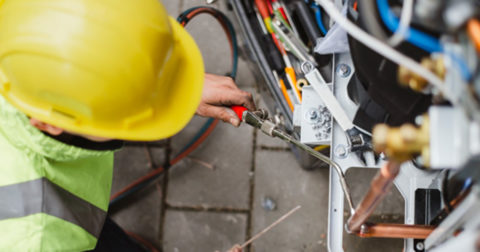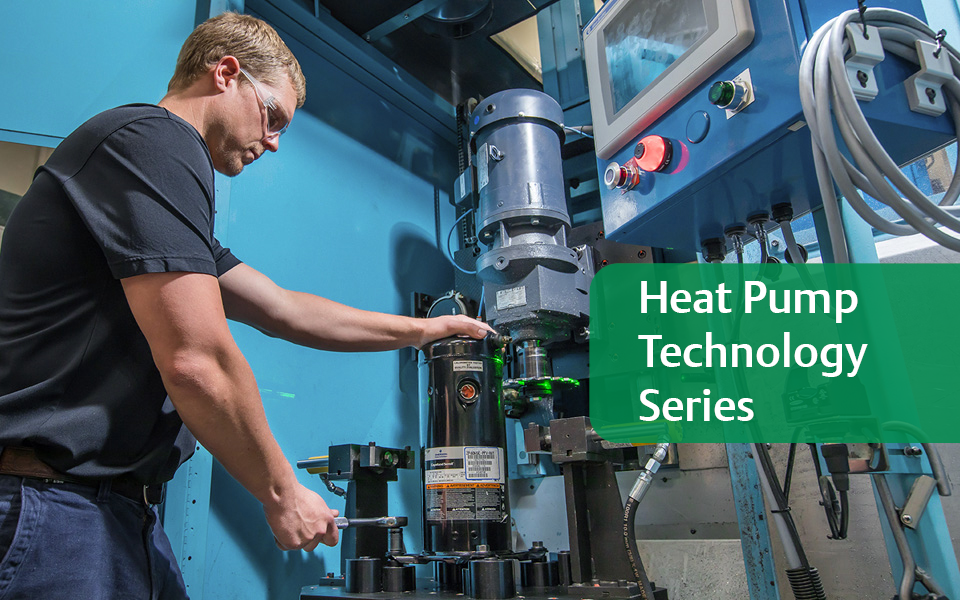System efficiency – A look into the future

*On June 1, 2023 Emerson’s Climate Technologies business became a new standalone company – Copeland. Though our name has changed, we are building on more than a century of HVACR innovation and industry leadership, and Copeland continues to offer the same products, industry stewardship, and learning opportunities you’ve grown to trust. Information found on this webpage posted before June 1, 2023 may contain our old name or branding, but you can be at ease knowing it was created with the knowledge and expertise of Copeland.
Previously we have looked at federal minimum energy efficiency levels and the metrics used today to rate air conditioning systems (such as SEER, integrated energy efficiency ratio, or full load EER). Now we are shifting focus and looking at system efficiency and where it is headed in the future.

Rated Equipment Efficiency Vs. System Efficiency
When talking about components – for example, compressors – the compressor’s efficiency is always discussed, often in terms of an isentropic efficiency. This measures the power or volumetric efficiency, giving an idea of how much refrigerant actually flows through the compressor. This can then be taken to a higher level in terms of COP, EER, SEER, etc. The problem with these is that they don’t necessarily cover the full operating conditions or the actual equipment application and how it performs.
One point that has come to the attention of many end customers and regulators is that over the last 30-40 years we are getting to a point where it is getting harder to squeeze energy efficiency out of single component pieces. Because of this, people have begun to look at how whole equipment systems perform at a building level when put together in a structure. This building level performance has become increasingly adopted both in the U.S. and overseas.
Decarbonization
Decarbonization is defined as any means used to reduce the carbon footprint of human activity. In the context of the HVAC industry, it relates to building decarbonization and reducing the carbon load put off by buildings through heating and AC. Several cities, especially those belonging to the U.S. Climate Alliance, refer to building decarbonization as a crucial step toward achieving overall decarbonization goals of net-zero or 80% reduction of emissions.
One of the main ways to reduce the carbon footprint in the HVAC industry is to try and reduce the load. Another vital factor is using lower global warming refrigerants to minimize system leaks. The third thing to focus on involves using higher energy efficiency systems and paying attention to the energy source.
Utility and policymakers tend to think more large scale rather than just at the component level, looking at energy sources and ways to reduce the amount of energy that buildings require. Source generation and moving to more renewable sources are key considerations when trying to reduce your carbon footprint in a holistic manner. California is currently a leader in using solar and wind renewables, while other areas of the country are just beginning to start that evolution.
Building Models
Taking a single piece of equipment and rating it at one condition or another is simple to complete in a lab. However, evaluating systems that have already gone into end-use in a building is much more difficult, especially when accounting for all the different conditions (occupancy, humidity, solar loading, etc.). The question becomes: how do we predict what the applied performance of a building will be like, and then how do we measure it?
This is where building models come into the picture. There are many models that have already been made and that are actively being developed. Organizations such as HRI, ASHRAE, and CSA play a large role in establishing standard sets of data for the industry. These standards bring about uniformity by creating norms on how data is presented, what to call different variables, and more.
Currently, these conversations are happening at the state level, but eventually, they will migrate down to the local level. As time goes on, contractors will be the ones communicating system efficiency to the broader group from a residential and commercial standpoint. Eventually, system efficiency will play a key role in the HVAC industry at all levels as we move forward into the future.

Exploring New Opportunities for CO2 at ATMOsphere America
by Andre Patenaude | Efficiency & Refrigerant Regulations, Heating & Air Conditioning, Refrigerants
*On June 1, 2023 Emerson’s Climate Technologies business became a new standalone company –...

Overcoming the Technological Barriers to Wider Heat Pump Adoption
by Brandy Powell | Heating & Air Conditioning
*On June 1, 2023 Emerson’s Climate Technologies business became a new standalone company –...

How U.S. Climate Legislation Is Driving Adoption of Sustainable Heat Pump Solutions
by Jennifer Butsch | Heating & Air Conditioning
*On June 1, 2023 Emerson’s Climate Technologies business became a new standalone company –...
The post System Efficiency – A Look into the Future appeared first on Copeland.